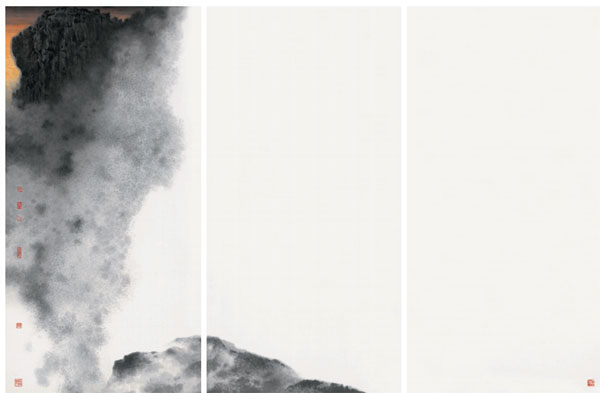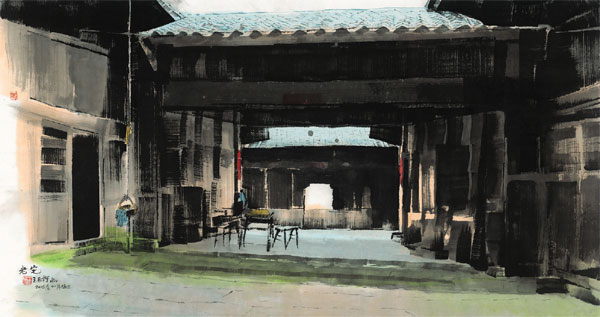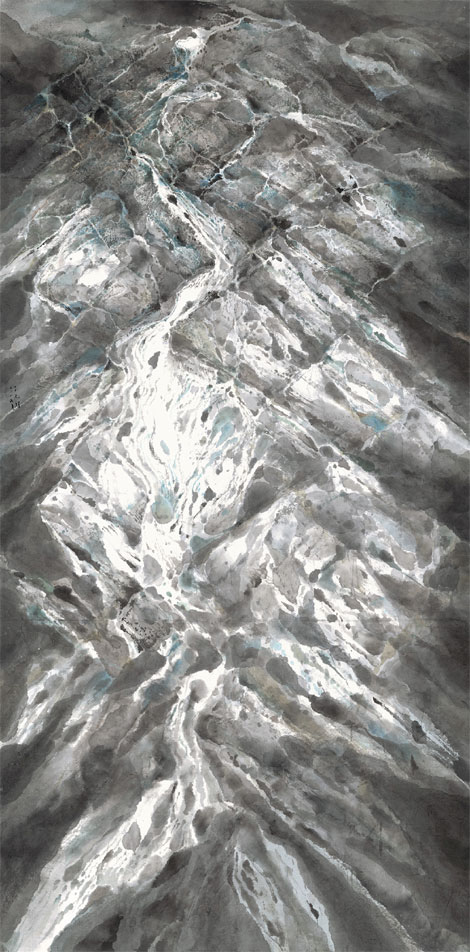Making a splash with ink art
Updated: 2017-08-03 07:46
By Chitralekha Basu and Miriam Zhang(HK Edition)
|
|||||||
|
Wong Hau-kwei's Fog Lifting from the Lion Rock is a fine example of manipulating the un-painted surfaces. Photos provided to China Daily |
|
Wang Changkai uses broad brushstrokes to create a three-dimensional, stereoscopic effect. |
|
The Great River by Wucius Wong is a study of mighty nature which is both real and dream-like. |
The Ink Global show, now on in HK, features a painting each by some of the finest artists from the world over using this traditional medium. A report by Chitralekha Basu and Miriam Zhang.
Probably the most refreshing aspect of the Ink Global show, which opens at the Hong Kong Convention and Exhibition Centre this week, is that it's not about money. Admission is free to this unique art exposition, dedicated to the evolution of Oriental ink art and its many contemporary manifestations across the globe. The 500 works in ink, laid out across a 150,000-square-foot exhibition space, are not on sale - a welcome departure from the usual investment-related buzz around such large-scale art events.
The Ink Global show, one in a series of several cultural events being held this year to celebrate the 20th anniversary of the establishment of the Hong Kong SAR, is primarily an exercise in sharing the many-splendored beauty of the traditional genre of ink art which seems to find newer expressions every day. As the curator of the Ink Global show, Kwok Ho-mun, says, "We wish to attract more art lovers to participate in the exhibition and activities, enhancing Hong Kong's status in the international art circle and build the city's reputation as the 'Asian hub of ink painting'. "
But then Hong Kong is already a popular destination with buyers of ink art, done in both contemporary and traditional styles. The big-time auction houses here earn a significant part of their revenue from Chinese ink paintings. A year ago, Zhang Daqian's ink and brush painting Peach Blossom Spring made history when it fetched $35 million. Museums have collected pieces from the last annual Ink Asia show - another art exposition dedicated solely to the medium of ink and especially its new adaptive, experimental forms. In a city where the interest in ink art seems to be perennially high, what might another show focused solely on the same medium help bring to the table?
A possible difference between Ink Asia and Ink Global - apart from that in the geographical regions covered - is that while the former is high on innovation and playing up the stunningly iconoclastic articulations of ink art, Ink Global is more interested in a close study of the scope of the ink art genre. At one level, Ink Global is a homage to different traditions of ink art. For instance, one of the highlights of the show, Autumn by He Jiaying, is executed in the gongbi tradition, which is about meticulous and precise attention to detail. Each vein of the yellowing leaves, each knit and purl of the woollen yarn in the pullover worn by the girl in the painting and each strand of the hair on the brow above her listless eyes could be told apart from the next one.
And again, Fog Lifting from the Lion Rock by Wong Hau-kwei is a marvelously subtle painting where a substantial part of the canvas is left blank. The painter informs us that this work follows the liu bai tradition, in which strategic placement of white un-painted spaces could suggest anything - the clouds, fog, water or the sky. Manipulating the blank space, he says, "is the most difficult part". "It's just like the idea of Zen in which everything visible is empty and the immaterial is the material," adds Wong, pointing us to the philosophical dimension of his awe-inspiring artwork.
500 artists
Although the best-known exponents of the contemporary ink genre - Liu Guosong, Wucius Wong and Lam Tianxing among several others - are part of Ink Global, the show is not about the stars. A joint initiative of Hong Kong's Wan Fung Art Gallery and Young Artists Development Foundation, the idea, from the outset, was to make Ink Global a non-commercial exposition, founded on democratic principles.
"Rather than taking into account the ages, nationalities and reputation of the artists, we were more concerned about whether the artists had developed their own unique style, mastered the professional techniques and created works to represent their artistic career," says Kwok, laying down the criteria for selection.
The exhibits were selected on the basis of a rigorously competitive procedure - where over 1,500 entries submitted from around the globe vied for a place among the last 500. Only one painting per artist has been included.
"The participating artists are from the five continents - Europe, Americas, Asia, Oceania and Africa," informs Kwok. "While most of them are from the Chinese mainland, Hong Kong and Taiwan, we also have participants from Belgium, Australia and Africa."
He draws our attention to the playful use of riotous colors in the painting of the Victoria Harbour by the Canadian Chinese artist Chen Tianen, commenting that an artist from Hong Kong or the Chinese mainland would probably go for more subdued and sophisticated colors and lines rather than something quite so in-your-face.
"Western artists express themselves more directly while their Eastern counterparts tend to be more understated," says Kwok. In the works by artists originally from the East who have since settled down in the West, there is often, understandably, a mix of inheritances from both cultures, sometimes to an intriguing effect. For instance, in a painting by the American Chinese artist Feng Changjiang - a very loose modern-day interpretation of the Three Graces - the technique, especially the lines indicating the drapery, are Oriental in sensibilities but the facial features of the women painted give them away as Western.
The road ahead
Half a century ago, when the current stalwarts in the field of ink art - Liu Guosong and Wucius Wong - had begun to break away from the traditional mode of ink painting and introduced iconoclastic techniques and concepts to the genre, they were greeted with much skepticism. Nonetheless, Liu and Wong continued to marry the extreme finesse achievable through the medium of ink with abstract, sometimes fantastical, themes, ultimately emerging as key figures of the genre in the 20th century.
Both artists have a painting each at the Ink Global show, which, coincidentally, depict similar landscapes - streams running down a rugged mountainous terrain. Created with remarkable adroitness, the paintings dazzle and disarm the viewer with their grandeur and precise execution.
"Back in the 1960s and 1970s, such experimental adaptation would be considered too deviant to be accepted as ink art," says Kwok. "Nowadays contemporary ink painting has become an important genre, earning wider appreciation. The increasing popularity of the works by Liu and Wong demonstrates that society is becoming more open, confident and free."
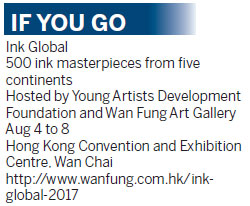
The painter Wong Hau-kwei, who has also taught ink art and is now a distinguished researcher at the Institute of Ink Painting of the China National Academy of Painting, too welcomes the increasing inclusivity in the field. "In the past, the art of Lingnan School dominated the realm but now more genres have emerged and we are more open to all of them."
He would, however, draw the line at accepting hybrid forms such as video or 3D adaptations of the genre as ink art, despite their rising popularity.
Kwok, on his part, sees "no contradiction between the traditional and modern".
"In the world of art, there is no difference between old and new, it's just good or bad," he says. In his opinion, ink art created during the Song Dynasty (960-1279) makes the benchmark. Many highly-rated contemporary specimens of ink art cannot touch such fine standards, says Kwok. "But then artists in that age did not have access to the modern apparatuses like we do."
Summing up the future of ink art, Kwok says, "The classics will never go out of date and at the same time by innovating and adapting continuously, ink art will register even bigger growth in the future."
By putting together an exhaustive catalogue of ink art in its several different incarnations in the present time, Ink Global is trying to add to our understanding of an ancient Chinese art tradition whose future could only get better.
Contact the writers at basu@chinadailyhk.com
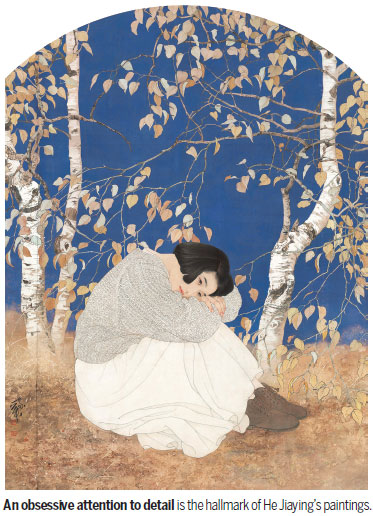
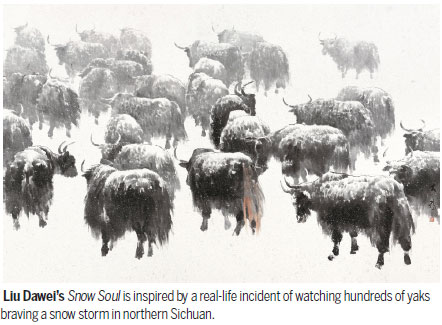
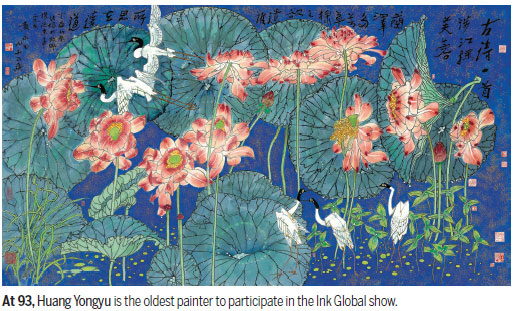
(HK Edition 08/03/2017 page19)
